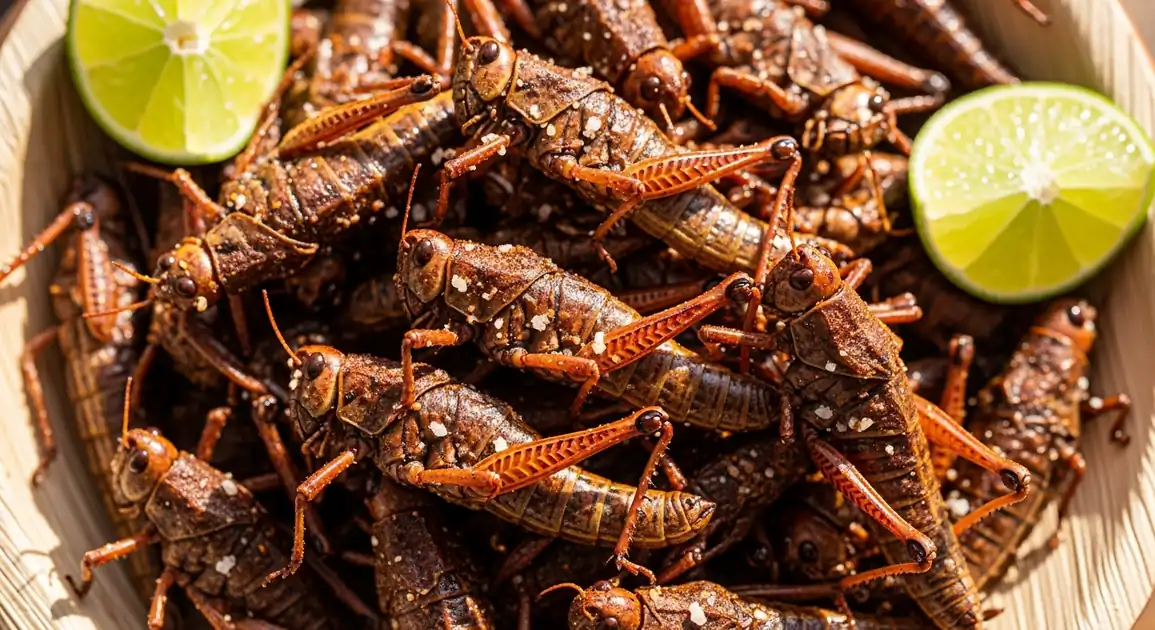Chapulines (Toasted Grasshoppers)
Chapulines

Description
In Mexico City, chapulines have transitioned from a regional Oaxacan specialty to a celebrated component of the capital's diverse culinary landscape. Found in traditional markets, upscale restaurants reimagining Mexican cuisine, and street food stalls in tourist areas, chapulines in Mexico City represent both authentic tradition and culinary innovation.
Dietary Information
Serving information
Serving style
In markets, sold by weight in plastic bags. In restaurants, served in small clay dishes (molcajetes), as taco toppings, or incorporated into contemporary Mexican dishes. Often garnished with lime wedges.
Quick facts
Markets: 8 AM - 6 PM, with best selection before 3 PM. Restaurants and bars: typical dinner hours, busiest 7 PM - 11 PM.
Safety Tips
What to Look For
-
Uniform reddish-brown color
Properly toasted chapulines should have a consistent color without black (burnt) or pale (undercooked) specimens.
-
Completely dry and crispy texture
Chapulines must be thoroughly toasted to eliminate any pathogens and ensure food safety. They should snap when broken, not bend.
-
Clean, sorted product
Quality vendors carefully clean and sort their chapulines, removing debris, dirt, and extraneous parts.
-
Fresh, aromatic smell
Good chapulines have a pleasant aroma of lime, garlic, and chile. Avoid any that smell musty, rancid, or off.
-
Vendors with high turnover
Busy stalls typically have fresher product and maintain better quality control.
What to avoid
-
Damp or soft chapulines
Inadequately toasted chapulines may contain harmful bacteria. They should never feel moist or soft to the touch.
-
Black or very dark specimens
Burnt chapulines taste bitter and may contain harmful compounds from overcooking.
-
Chapulines with visible dirt or debris
Poor cleaning indicates substandard preparation practices that may impact food safety.
-
Stale or off-smelling product
Old or improperly stored chapulines can develop mold or rancidity. They should smell fresh and appetizing.
-
Exceptionally cheap prices
Quality chapulines require labor-intensive preparation. Suspiciously low prices may indicate shortcuts in cleaning or preparation.
Price information
Price range
Budget tips
- Markets like Mercado de San Juan offer the best value, typically 30-60 MXN for a small portion.
- Prices increase significantly in upscale restaurants where they may be used as garnishes or in fusion dishes (100-200 MXN).
- Markets in more touristic areas like Centro Histórico typically charge 20-30% more than local neighborhood markets.
- Specialty food stores in upscale neighborhoods like Polanco or Condesa charge premium prices.
Value indicators
- Clean, uniform appearance.
- Properly sorted by size.
- Aromatic smell of lime and spices.
- Sold by knowledgeable vendors who can explain their origin.
- Crisp texture without excessive salt.
Where to Find This Dish
Mercado de San Juan
Mexico City's gourmet market featuring stands specializing in insects and exotic foods. The most reliable source for quality chapulines.
Central section of the market, Specialized Oaxacan products stands
10 AM - 5 PM daily, best selection before 3 PM
La Merced Market
Traditional large market with several vendors selling chapulines, typically at better prices than tourist areas.
Dried goods section, Oaxacan products area
Morning to Afternoon
Centro Histórico
Tourist-oriented vendors near main attractions sometimes sell small portions of chapulines as a novelty food.
Streets surrounding Zócalo, Near Templo Mayor
Afternoon, Early Evening
Condesa and Roma
Trendy neighborhoods where upscale restaurants and mezcalerías serve creative dishes featuring chapulines.
Mezcal bars, Contemporary Mexican restaurants
Evening (7 PM - 11 PM)
Vendor Tips
- In Mexico City, ask if chapulines are from Oaxaca, as they're typically transported from there.
- At markets, observe if the vendor keeps them covered and how they handle them.
- Specialty vendors in Mercado de San Juan often have the best quality and knowledge.
How to Order
Regional Variations
-
Gourmet Chapulines
(Chapulines Gourmet)
Mexico City restaurants often create upscale versions with premium ingredients or unique preparation methods, such as being seasoned with artisanal salts or exotic chiles.
-
Chapulines in Contemporary Cuisine
(Chapulines en Cocina Contemporánea)
Innovative uses in dishes like chapulín risotto, tlayudas with chapulines, or even chapulín salt for rimming cocktail glasses, particularly in trendy neighborhoods.
-
Market-Style Chapulines
(Chapulines Estilo Mercado)
Traditional preparation maintaining Oaxacan techniques, typically found in markets and stores specializing in products from southern Mexico.
Cultural context
History
Chapulines have been consumed in Mexico since pre-Hispanic times, with archaeological evidence dating back thousands of years. Indigenous peoples, particularly Zapotecs and Mixtecs in what is now Oaxaca, harvested these protein-rich insects as a sustainable food source. The Spanish conquest documented their culinary use in the 16th century. Traditional preparation methods have been passed down through generations, with each region developing particular seasoning preferences. While historically associated with rural and indigenous communities, chapulines have gained popularity nationally and internationally as interest in traditional Mexican cuisine and sustainable protein sources has grown.
Local significance
In Mexico City, chapulines represent both a connection to traditional Mexican cuisine and the capital's role as a showcase for regional foods from across the country. They've been embraced as part of Mexico's gastronomic heritage.
Eating customs
- In markets, eaten as a snack with fresh lime.
- In restaurants, often incorporated into guacamole or as taco toppings.
- In mezcalerías, served as the traditional accompaniment to mezcal flights.